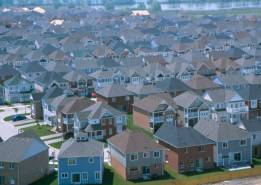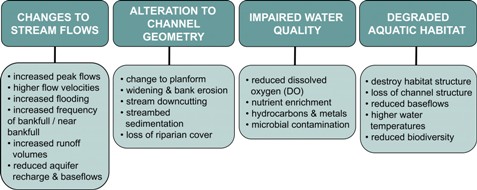Urban Water Balance
 The abundance of impervious cover in urbanized watersheds fundamentally alters the natural water balance. The term urban water balance describes the way rainfall is partitioned in this altered landscape.
The abundance of impervious cover in urbanized watersheds fundamentally alters the natural water balance. The term urban water balance describes the way rainfall is partitioned in this altered landscape.
As pervious vegetated areas are stripped and replaced with buildings and pavements, surface runoff becomes the dominant process in the water budget, while opportunities for groundwater infiltration are reduced. Since cities are intentionally engineered to drain stormwater quickly to prevent flooding of built up areas, they provide little in the way of surface depression storage and are therefore less effective at evaporating rainfall. This situation is further exacerbated by the reduction in absorptive surfaces, trees and vegetation, that temporarily store and evaporatranspire water.
The shift to an urban water balance has adverse impacts on the quality and quantity of both groundwater and surface water features. As groundwater infiltration is reduced, rainfall that previously replenished aquifers is instead conveyed to surface water bodies, contributing to altered flow regimes, channel erosion and other related impacts summarized in the following chart (click to open in a larger view).
Infiltrating rainwater also serves as an important mechanism for protecting the quality of surface and ground water, as vegetation and soil act as effective filters to contaminants in stormwater infiltrating into the ground. A shift towards increased overland runoff in the urban water balance removes this filtering mechanism, resulting in higher contaminant loads to surface water bodies.

